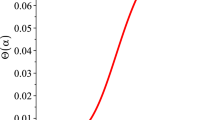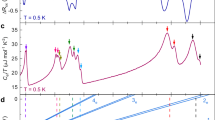Abstract
SOME years ago, one of us (K. S. K.) suggested a new method of determining the thermionic constants of solids. The method is based on the determination of the saturation vapour pressure of the electron gas in equilibrium with the substance at different known temperatures. In practice, this is done by finding the rate of effusion into vacuum of electrons out of a small hole in a thin wall of a chamber scooped out of the substance. Using a well-known thermodynamic relation, analogous to the Clapeyron–Clausius equation connecting the temperature variation of the saturation vapour pressure of a given substance with its latent heat of evaporation, one obtains readily the thermionic constants. The work function of graphite was determined by this method by Dr. A. S. Bhatnagar1, and of a few other substances by Dr. S. B. L. Mathur2; but the A coefficients in Richardson's equation were not determined by these authors, owing to uncertainties in some of the absolute measurements.
This is a preview of subscription content, access via your institution
Access options
Subscribe to this journal
Receive 51 print issues and online access
$199.00 per year
only $3.90 per issue
Buy this article
- Purchase on Springer Link
- Instant access to full article PDF
Prices may be subject to local taxes which are calculated during checkout
Similar content being viewed by others
References
Proc. Nat. Acad. Sci., Ind., A, 14, 5 (1944).
Doctorate thesis, University of Allahabad; see also Proc. Ind. Sci. Cong. Assoc. 1950, p. 23.
Author information
Authors and Affiliations
Rights and permissions
About this article
Cite this article
KRISHNAN, K., JAIN, S. Thermionic Constants of Graphite. Nature 169, 702–703 (1952). https://doi.org/10.1038/169702c0
Issue Date:
DOI: https://doi.org/10.1038/169702c0
Comments
By submitting a comment you agree to abide by our Terms and Community Guidelines. If you find something abusive or that does not comply with our terms or guidelines please flag it as inappropriate.



